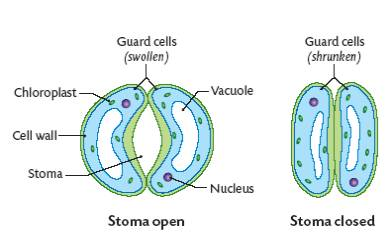Chapter 24: Transport, Storage, and Gas Exchange in Flowering Plants
Root Hairs
Extensions of the root epidermis.
They are specially adapted for absorption by:
Thins walls
- Easier for osmosisNot covered by a cuticle
- Increased absorption of H2ONumerous (large surface area)
- Increased absorption of H2O
Water Uptake by Roots
- Soil is surrounded in a layer of pure water (capillary water).
- The cytoplasm of the root hairs contains dissolved solutes which allow the water to move in by osmosis.
- Water continues to diffuse until it reaches the xylem.
Upward Movement of Water
Upward movement of water depends on two mechanisms, root pressure and transpiration.
Root Pressure
Water enters the xylem through osmosis.
Continuous movement of water creates pressure.
Pressure pushes water up through xylem.
Another process must be involved as it is a weak force.
Transpiration
The loss of water vapour (by evaporation) from the leaves and other aerial parts of the plant.
Most transpiration occurs through the openings called stomata, water moves from the cells in the leaves into the atmosphere.
As each water molecule evaporates it pulls another water molecule to replace it. This flow of water is called the transpiration system.
Control of Transpiration
At certain times, it is necessary for plants to reduce their water loss by transpiration.
This can be done by:
Presence or absence of a cuticle.
- A cuticle is a waxy layer through which water cannot pass through. It does not cover the stomata on the underside of the leaf.Stomata are on the underside of the leaf, away from direct sunlight which reduces transporation as it is cooler.
Each stoma is surrounded by two guard cells. These guard cells open and close. During the day the stomata are open, which allows for gas exchange during photosynthesis, and during the night they close to reduce water loss.
During adverse weather, e.g. high temperatures, lack of water, high winds, the stomata will remain closed.
Cohesion - Tension Model of Water Transport in Xylem
- Dixon and Joly
Cohesion: the sticking together of similar molecule, e.g. water.
Adhesion: occurs when different molecules stick together, e.g. water and xylem tissue.
Water evaporates from xylem tissue into air spaces in the leaf.
- As transpiration pulls water from xylem, another water molecule is pulled along with it.
- This is caused by water’s high cohesion.
- This process extends down to roots.
- Transpiration and cohesion creates a pulling force.Transpiration puts the column of water under tension.
- Tension is strong enough to pull water to a height of 150m.Stomata open during the day and transpiration occurs.
- Constant tension in the water column causes the xylem to narrow by day.
- Xylem has thick lignified walls.Transpiration stops at night which creates a lack of tension and xylem returns to original shape.
Mineral Uptake and Transport
Minerals needed for synthesizing plant components:
Calcium
Magnesium
Nitrates
Phosphates
Potassium Ions
They enter root hairs, are dissolved in water, enter by diffusion or active transport.
They are transported by xylem.
Active Transport:
Movement of a substance from an area of high concentration to an area of low concentration through a membrance facilitated by a protein. It is an active process, so it requires energy.
Carbon Dioxide Uptake and Transport
Carbon dioxide is needed for photosynthesis.
Two sources of carbon dioxide are:
External: Carbon dioxide diffuses into air spaces, and then ground tissue where photosynthesis occurs.
Internal: Carbon dioxide is produced during respiration, and can be used in photosynthesis. Higher temperature increases carbon dioxide production, as there is increased respiration.
true rate of photosynthesis = rate of carbon dioxide absorbed by stomata + rate of carbon dioxide produced in respiration
Formula for true rate of photosynthesis.
Products of Photosynthesis
Oxygen
Oxygen produced can diffuse into air spaces in the leaf.
From there it diffuses through stomata into the atmosphere.
Some oxygen is used in the leaves for respiration.
Glucose
C6H12O6 is a carbohydrate made during photosynthesis.
Used immediately for respiration.
Converted to starch for storage.
Converted to sucrose and transported in the phloem.
Modified Food Storage in Plants
Modified Root
In dicot plants (carrots, beetroot, turnips) one main tap root is produced. Tap root anchors and absorbs water.
Root becomes swollen with starch.
Modified Stem
Potatoes form underground stem systems, where tips of stems became swollen with starch. Swollen tips are called stem tubers.
Modified Leaves
Garlic and onions produce bulbs - swollen leaves.
Modified to store food.
Leaves surround central apical bud, e.g. lettuce, cabbage.
Gas Exchange
Sites of Gas Exchange
Branch and stems → Lenticels
Leaf → Stomata
Gas Exchange - Leaf
Carbon dioxide diffuses through stomata.
Millions of stomata.
Oxygen is diffusing outwards as well.
Excess water lost through stomata.
Loss of water vapour is called transpiration.

Gas Exchange - The Stem
Bark does not normally allow gas exchange, however lenticels in the bark allow gas exchange. They appear as tiny blisters on the bark’s surface.
Stomatal Opening and Closing
Each stomata is surrounded by two guard cells.
Kidney shaped, inner wall is thicker than the outside.
Gap between buckled cells after absorbing water through osmosis is called stomata.
High Carbon Dioxide - At night when no photosynthesis is occurring, stomata close as build up of carbon dioxide in the leaf spaces occurs.
 Knowt
Knowt